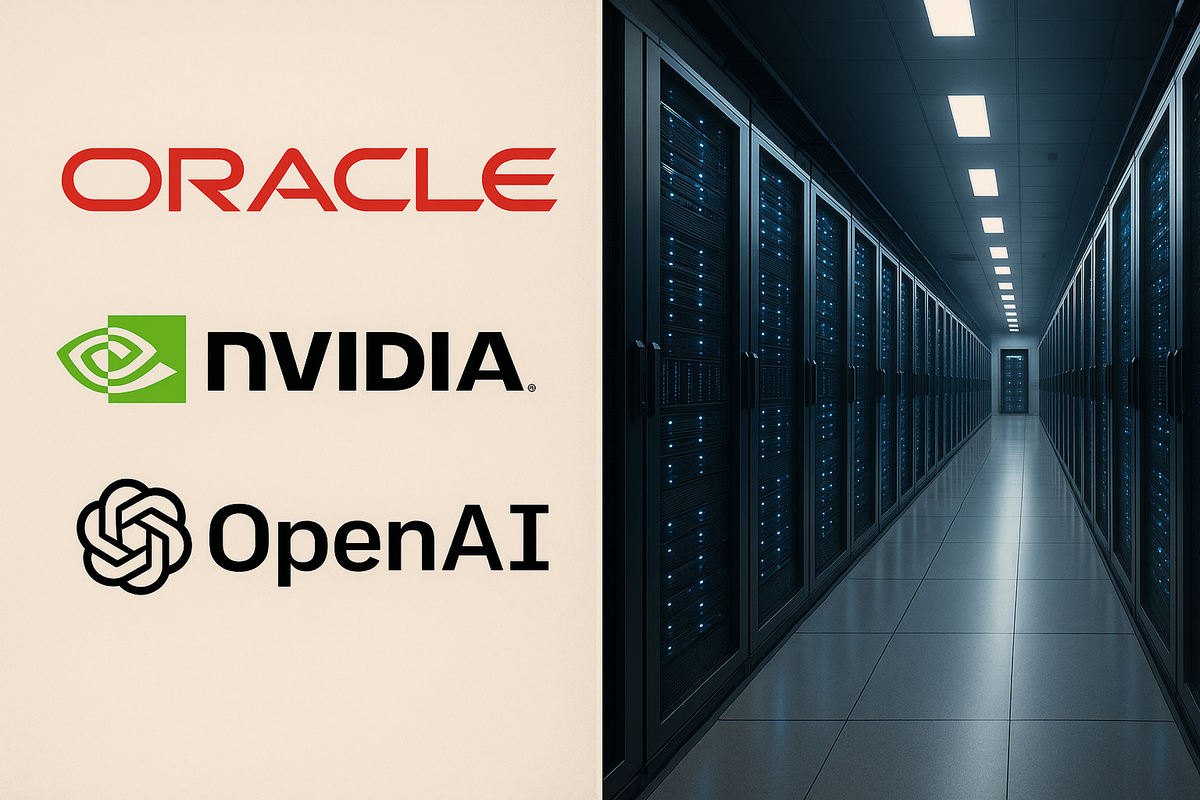Oracle Fires $40B Shot in the AI Arms Race: NVIDIA, OpenAI, and the Cloud Cartel Reshape Global Compute

Oracle has just made one of the largest strategic bets in tech history. The Financial Times reports the company is spending $40 billion on NVIDIA GPUs to build out a U.S. data center for OpenAI.
This is not a routine capex line. It is a live fire entry into the frontlines of the AI infrastructure war. The magnitude of this deal redefines Oracle’s place in the cloud market and signals the formal emergence of what can only be described as the Compute Cartel: a coalition of hyperscale operators, semiconductor monopolists, and AI software platforms consolidating global control over intelligence infrastructure.
This report outlines how Oracle’s move fits into the larger picture, compares the power positions of cloud giants and chip suppliers, and presents the investment angles traders need to understand now.
Oracle's Move: $40 Billion for Compute Sovereignty
Oracle’s rumored deal to buy 400,000+ NVIDIA GPUs to support OpenAI’s new Texas data center is, by any metric, astonishing. This single order is equivalent to Oracle’s total cloud revenue for 2024. It marks a pivotal moment in OpenAI’s infrastructure diversification, signaling a move away from exclusive reliance on Microsoft Azure. The facility, located in Abilene, Texas, will operate under a 15-year lease structure and is projected to draw 1.2 gigawatts of power upon completion.
OpenAI’s compute appetite now outpaces Azure’s capacity. Oracle is seizing the opportunity. The infrastructure project is part of OpenAI’s broader Stargate initiative: an attempt to deploy up to $500 billion in AI supercomputing capacity over the next decade, reportedly backed by SoftBank and other investors.
Oracle's deep alignment with NVIDIA and its tight integration of database and compute services position it uniquely as both landlord and systems integrator for high-end AI workloads.
The Capex War: Intelligence Infrastructure or Industrial Arms Race?
Big Tech’s capital spending in 2025 is historic. The cloud hyperscalers are pouring hundreds of billions into AI infrastructure. Unlike past capex cycles tied to incremental cloud growth, this wave is centered entirely on compute density, GPU scale, and real-time inference delivery at global scale.
Capital Expenditure by Major Players (2025 Estimates)
| Company | Estimated Capex | Primary Focus | Year-over-Year Growth |
|---|---|---|---|
| Microsoft | $80 billion | Azure AI infrastructure, custom silicon | Up ~50% |
| $75 billion | TPU-based regions, 11 data center zones | Up ~43% | |
| Amazon | $100 billion | AWS AI cloud factories, Trainium/Inferentia | Up ~40% |
| Meta | $60-65 billion | Internal AI capacity, Louisiana supercenter | Up ~80-100% |
| Oracle | $40 billion | NVIDIA GPU order for OpenAI Stargate center | Order magnitude |
Microsoft, Google, and Amazon are each scaling data center operations faster than in any period since the early 2010s. Meta’s shift is particularly notable. From a social network, it is morphing into an AI hardware operator. Oracle, for its part, has leapfrogged into relevance through massive NVIDIA procurement and a long-term lease model that bypasses traditional cloud barriers.
GPU Monopoly Economics: NVIDIA’s Unmatched Leverage
NVIDIA has achieved what is arguably the most lucrative hardware monopoly in modern tech history. In 2024, it controlled 92 percent of the AI accelerator market by revenue. All major model training pipelines, from OpenAI’s GPT to Meta’s LLaMA to Amazon’s Bedrock, depend on NVIDIA silicon.
H100s are priced at $100,000 per unit, and NVIDIA's roadmap includes B100 and Rubin-class chips delivering exponential gains. No other supplier matches the CUDA software ecosystem or the networking stack NVIDIA provides through its Mellanox subsidiary. The practical effect is lock-in across the AI supply chain.
Estimated AI GPU Holdings by Major Operators (2025 Projections)
| Company | AI GPUs in Operation | Notes |
|---|---|---|
| Meta | 1.3 million | Largest private deployment |
| OpenAI | 500,000+ | NVIDIA GPUs via Oracle and Microsoft |
| Microsoft | 600,000+ | Mix of H100s and custom Athena chips |
| TPU based | Custom chips, not counted as GPUs | |
| Amazon | Mixed deployment | H100s + Trainium + Inferentia |
The bottleneck in AI is not software. It is compute. GPU access is now a competitive moat. While rivals like AMD and Intel attempt to enter the space, NVIDIA’s dominance is a function of both hardware and a decade of ecosystem entrenchment.
Hyperscale as National Infrastructure
The emerging AI data centers are closer to industrial zones than cloud regions. Power draw is measured in gigawatts. Cooling systems rival those of military installations. The scale is geopolitical.
Key AI Hyperscale Projects (2025-2027 Buildouts)
| Project | Sponsor | Power Rating | Scale | Completion |
|---|---|---|---|---|
| Stargate Texas | Oracle/OpenAI | 1.2 GW | 4M sq ft | 2026 |
| Meta Louisiana Campus | Meta | 2.0 GW | 4M+ sq ft | 2030 |
| AWS Virginia Hub | Amazon | 1.1 GW | 5 data center blocks | 2027 |
| Azure AI Global Build | Microsoft | 1.5 GW+ | 50+ regions | 2025+ |
| TPU Expansion | NA | 11 new zones | Ongoing |
These sites are being treated as strategic assets. Oracle and OpenAI’s Stargate is supported by the U.S. Department of Commerce. Meta’s campus is the size of 40 percent of Manhattan. Amazon’s footprint in Northern Virginia now rivals that of mid-sized utilities.
Investment View: Strategic Advantage and Public Market Implications
The implications of these moves span multiple verticals. For investors, the thesis rests on three pillars.
1. NVIDIA is a High-Leverage Monopoly
NVIDIA remains the purest play on AI infrastructure expansion. Its valuation has reached rarefied territory, but margins remain underwritten by a GPU demand curve that is steepening rather than flattening. Any temporary supply-chain disruption or geopolitical flashpoint could further raise prices.
2. Oracle is the Best-Rated Surprise in Cloud
Once a laggard, Oracle is now structurally tied to OpenAI and may emerge as a key compute lessor in the AI economy. Its stock remains discounted relative to hyperscaler peers, but its upside potential in GPU monetization is considerable. Oracle Cloud Infrastructure (OCI) is leaner and more GPU-centric than Azure or AWS.
3. Meta is Building the Largest AI Capacity in Silence
Zuckerberg's pivot to AI is not symbolic. Meta is acquiring compute capacity on a scale that rivals AWS. This includes internal chip development and multi-gigawatt data centers. The company is positioning for generative AI, recommendation systems, and metaverse integration with AI foundation models.
Compute is the New Oil
The AI race is not about apps. It is about power. Compute power. Whoever owns the infrastructure will own the next phase of digital intelligence.
The parallels to the 20th-century energy race are clear. NVIDIA is OPEC. Microsoft is Exxon. Oracle is Saudi Aramco emerging from obscurity with leverage through scale. Meta is stockpiling like a sovereign.
Investors who understand this transition, from software to silicon and from APIs to gigawatts, will position themselves ahead of the next trillion-dollar market rotation.
This time, it won't be the app that wins. It will be the infrastructure underneath.
